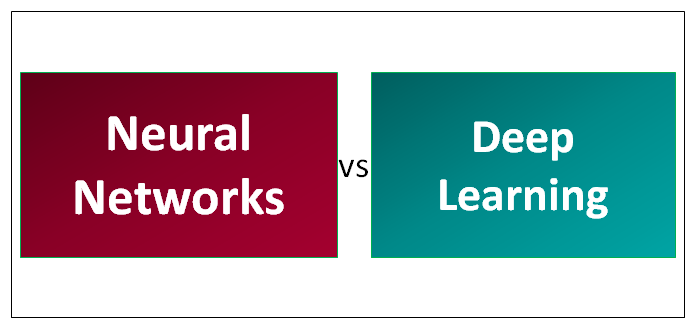Updated June 15, 2023

Difference Between Neural Networks vs Deep Learning
With the huge transition in today’s technology, it takes more than just Big Data and Hadoop to transform businesses. Today’s firms are moving towards AI and incorporating machine learning as their new technique. While doing this, they do not have any prior knowledge about the characteristics of cats, but they develop their own set of unique features, which is helpful in their identification. This is based upon learning data representations which are opposite to task-based algorithms. It can further be categorized into supervised, semi-supervised, and unsupervised learning techniques. Let us discuss Neural Networks and Deep Learning in detail in our post.
Head to Head Comparison Between Neural Networks and Deep Learning (Infographics)
Below is the top 3 Comparison Between Neural Networks and Deep Learning:
Key Differences Between Neural Networks and Deep Learning
- Neural networks make use of neurons that are used to transmit data in the form of input values and output values.
- Application areas for neural networking include system identification, natural resource management, process control, vehicle control, quantum chemistry, decision making, game playing, face identification, pattern recognition, signal classification, sequence recognition, object recognition, finance, medical diagnosis, visualization, data mining, machine translation, email spam filtering, social network filtering, etc.. In contrast, the application of deep learning includes Automatic speech recognition, image recognition, visual art processing, Natural language processing, drug discovery and toxicology, customer relationship management, recommendation engines, Mobile advertising, bioinformatics, Image restoration, etc.
- Criticism encountered for Neural networks includes those training issues, theoretical issues, hardware issues, practical counterexamples to criticisms, and hybrid approaches. In contrast, deep learning, it is related to theory, errors, cyber threats, etc.
Neural Networks and Deep Learning Comparison Table
Below is some key comparison between Neural Networks and Deep Learning.
| Basis for comparison | Neural Networks | Deep Learning |
| Definition | Class of machine learning algorithms where the artificial neuron forms the basic computational unit and networks are used to describe the interconnectivity among each other. | It is a class of machine learning algorithms that uses non-linear processing units’ multiple layers for feature transformation and extraction. It also represents concepts in multiple hierarchical fashions corresponding to various levels of abstraction. |
| Components | Neurons: Neuron j receives input from its predecessor neurons, typically in the form of an identity function, to generate an output. Connections and weights: The connection is a vital component between the output neuron i and the input neuron j. Propagation function: It provides an input for the resulting output. Learning rule: It is used to modify the parameters of a neural network so as to result in a favorable output. |
Motherboard: The motherboard chipset is a component related to deep learning, which is particularly based on PCI-e lanes. RAM, physical memory, and storage: The deep learning algorithms require great CPU usage, storage, and memory area, and so having a rich set of these components is a must. PSU: With the increase in memory, CPU, and storage area, it also becomes important to use a large PSU enough to handle huge power. |
| Architecture | Feed Forward Neural Networks: The commonest kind of architecture contains the first layer as the input layer. In contrast, the last layer is the output layer, and all the intermediary layers are the hidden layers. Recurrent networks: This kind of architecture consists of directed cycles in the connection graph. The biologically realistic architectures can also take you back from where you started. Symmetrically connected networks: Symmetrical connection holding architecture which is more or less like the recurrent networks. On the other hand, Hopfield nets, which do not have a hidden layer, are another type of neural network. |
Unsupervised Pretrained Networks: In this architecture, we discuss no formal training, but the networks are pretrained using past experiences. This includes autoencoders, deep belief networks, and generative adversarial networks. Convolutional Neural Networks: It aims to learn higher-order features using convolutions which betters the image recognition and identification user experience. Identification of faces, street signs, platypuses, and other objects becomes easy using this architecture. Recurrent neural networks: They come from the family of feedforward, which beliefs in sending their information over time steps. Recursive neural networks: It also marks variable length input. The primary difference between recurrent and recursive is that the former can devise the hierarchical structures in the training dataset. |
Conclusion
AI is an extremely powerful and interesting field that only will become more ubiquitous and important moving forward and will surely have huge impacts on society as a whole. These two techniques are some of AI’s very powerful tools to solve complex problems and will continue to develop and grow in the future for us to leverage them.
Recommended Articles
This has been a guide to Neural Networks vs Deep Learning. Here we have discussed Neural Networks vs Deep Learning head-to-head comparison, key differences along with infographics and comparison table. You may also look at the following articles to learn more –

